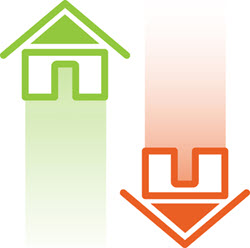 There are two basic types of real estate markets: Linear and Cyclical.
There are two basic types of real estate markets: Linear and Cyclical.
Cyclical Markets
Cyclical markets are real estate markets that tend to have larger price moves up and down over the years. Property values move up and down like a roller coaster ride with noticeable peaks and troughs. They are the shooting stars of housing booms (and busts). Cycle lengths vary between markets but often last between 7 to 10 years from end to end.
Many of the cyclical markets are found along the east and west coast of the United States where household incomes are higher and land for new construction is in shorter supply (i.e. California, New York, New Jersey) as well as a many parts of Florida.
When conditions are ripe annual housing price gains in these areas can exceed 20 to 30 percent at the cyclical peak. However, the local booms burn themselves out by pushing prices to unaffordable levels.
I often refer to some of these markets as “bubble” markets because they can appreciate in value so dramatically in a relatively short period of time them come “crashing” down as the economy changes bringing property values back down as quickly as they went up – often at double-digit rates.
Linear Markets
Linear markets are real estate markets with a more “flat” growth curve over time. That is they have a more visually smooth and steady growth with no major spikes or declines. Linear markets are where booms and busts virtually never occur.
Some people may call them “boring” markets because of their relatively “lower” annual appreciation rates, but they are happen to be the markets that provide some of the best capitalization rates and cash-on-cash returns!
Many of the linear markets are found in the interior Middle-American heartland (Midwest) as well as some of the southern (Texas) and south-eastern (Georgia, Tennessee) states of the United States.
Hybrid Markets
Hybrid markets are areas that have linear, slow-growth characteristics for a period time, followed by periods of moderate cyclical-style appreciation. They never boom quite like Florida or California, but they also never need to correct like the more volatile markets either.
Markets like Phoenix, Las Vegas, Chicago, Seattle, Minneapolis-St. Paul, and Detroit are in this category.
Comparing Markets
Although each market has different characteristics, one is not necessarily better than the other. Each market offers the real estate investor different levels of appreciation and cash-on-cash returns. Some investors may not sleep well at night investing in a cyclical market and prefer the pace of a linear market. While other investors may find a linear market to slow and prefer to see greater appreciation potential. However, over the long-term appreciation rates in both market types end up being similar. So the idea of chasing appreciation (what I call speculating) should be avoided.
Focus your investing in good markets and neighborhoods and you will be very success.



